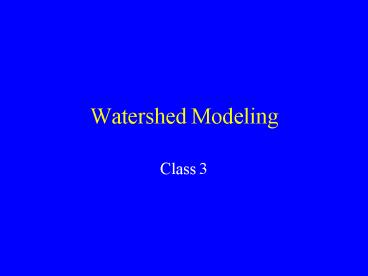Watershed Modeling - PowerPoint PPT Presentation
1 / 23
Title:
Watershed Modeling
Description:
This says nothing about repeated, periodic exposures, as with urban runoff. ... 'Free' metals include the most toxic ionic forms, as well as other labile forms. ... – PowerPoint PPT presentation
Number of Views:62
Avg rating:3.0/5.0
Title: Watershed Modeling
1
Watershed Modeling
- Class 3
2
Assessment Pick an Image
3
Aquatic Biological Impacts of Urban Land Use
- Typical, but complex, effects
- Chemical, Physical, Biological
- Biological altered interactions organism
death - Regulatory attempt to avoid adverse impacts
- Biological damage still can occur when chemical
water quality criteria have been met - Variable exposure patterns, toxicity
- Chemical transformations after release
interactions - Diluted pollution still hurts
- Cumulative impact
- Pollutant accumulation (examples beyond sediment)
4
Environmental Concerns, Impacts their Causes
- Multiple uses
- Groundwater
- Aquatic habitat
- Water supply
- Wildlife habitat
- Recreation
- Agricultural
- Negative impacts
- Causes
- Altered discharge
- Suspended solids
- Urban pollution
5
Environmental Concerns Impacts Contd
- Urbanization impacts are multifaceted
- Tree removal reduces interception
- Loss of duff top soil removes soil reservoir
- Regrading eliminates natural depressions
- New conveyance systems (pipes)
6
Hydrologic Related Physical Impacts
- Typical hydrographs before/after urbanization
- 2 to 5 fold increase is common (Leopold, 1968)
- Channel flooding is common
- Faster response is common
- Lower flows in dry periods is common
7
Ecological Consequences of Hydrologic Changes
- Erosion of stream channel
- Rapid incision of the channel
- Sediment deposits in pools eggs
- Suspended sediment abrades gills
- Loss of riparian veg. shade
- Loss of woody debris food
8
Urban Runoff in Lake Eutrophication
- Degrades ecosystem in several ways
- Filamentous algae are poorer food than diatoms
- Algae clog water intakes
- Algae reduce clarity
- Algae impact swimming
- Algae death lead to anoxia
9
Continuous vs. Intermittent (3/24hr) Zinc Exposure
- Same concentration total load 122mg vs. 90 mg
- Same species tolerate toxicity differently
- Gradual decline for continuous (11.3 days)
- Acclimation defense mechanisms may develop
- Load vs. Delivery
Extinction by 2nd treatment
10
Metals Toxicity in Fish (Davies, 1986)
- Increases in pH, alkalinity, and hardness
decreases metal toxicity - Runoff discharge into well buffered waters with
most metals in solid state creates less toxic
reactions than dissolved metal discharge into
soft waters
11
Metals Toxicity in Fish (2/11)
- Metal toxicity generally increases as temp.
increases because of increased metal activity
metabolism - Runoff discharge in the winter and runoff into
shaded or groundwater-fed waters in the summer
creates less toxic reactions than into warmer
waters.
12
Metals Toxicity in Fish (3/11)
- Smaller, younger organisms are more sensitive to
metals, and fish are generally more sensitive
than macroinvertebrates. - Runoff discharge during rearing periods creates
more toxic reactions than during adult stages.
13
Metals Toxicity in Fish (4/11)
- If exposed during the embryonic stage in soft
water, fish can acclimate to metals and are less
sensitive to higher exposures later. - Relatively low continuous exposures throughout
life can somewhat insulate fish from periodic
elevated exposures in runoff.
14
Metals Toxicity in Fish (5/11)
- Metal toxicity increases as exposure period
lengthens. - Fish can better tolerate a high exposure for a
short interval than continuous delivery. This
says nothing about repeated, periodic exposures,
as with urban runoff.
15
Metals Toxicity in Fish (6/11)
- The apparent mechanism of acute (1 to 4 days)
metal toxicity in fish is gill irritation by the
ionic metal, causing mucus secretion internal
destruction of the gill, resulting in suffocation.
16
Metals Toxicity in Fish (7/11)
- Free metals include the most toxic ionic forms,
as well as other labile forms. Most or all metals
present can be free in soft waters, but can be a
small fraction of total metals in hard waters. - In hard waters, fish can withstand much higher
total metals, but toxicity to free metals is the
same in both hard and soft water.
17
Metals Toxicity in Fish (8/11)
- Chronic toxicity exhibits trends similar to acute
toxicity with respect to free and total metals,
but at much lower levels.
18
Metals Toxicity in Fish (9/11)
- Complexation, which reduces toxic free metals, is
not instant (2 days for Cd), and mortality
increases in tests with unaged water. - Urban runoff dynamics do not allow time for
complexation, and therefore buffering is a
smaller benefit with intermittent than with
continuous releases.
19
Metals Toxicity in Fish (10/11)
- Toxic concentrations are frequently measured in
natural water samples, but all fish still live. - This contraction stems partly from acclimation
and partly from comparing a standard meant for
continuous exposure with a condition that is only
intermittent, as well as using acid to preserve
samples (which frees metals)
20
Metals Toxicity in Fish (11/11)
- The use of dissolved metals measurement can only
approximate the toxic forms because some are
solubilized over time. - Realistic water quality criteria for waters
affected by urban runoff require considering
duration and frequency of exposures, chemical
forms, and species.
21
Thermal Impacts of Urban Runoff (Washington
State)
- Air temp. strongest control on stream temp.
- Avg. stream temp. increased linearly with
impervious area percentage - Criteria violations occurred w/ 12 impervious
area - Structural treatment practices w/ surface
discharge had violations of temp. criteria under
baseflow and stormflow
22
Thermal Impacts of Urban Runoff (2/2)
- Order of practices in raising receiving water
temp. causing violations, from least - Infiltration basin lt extended-detention wetlands
lt extended-detention dry ponds lt wet ponds - Thermal conditions could cause algal succession
from cold water (diatoms) to water-water
filamentous greenblue algae - Implications on shade pool outlet design
23
Fish Habitat Impacts Habitat Protection
- Life Cycle Characteristics
- Habitat Requirements function of life stage































